The Perceived Restorativeness of Outdoor Spatial Characteristics for High School Adolescents: A Case Study from China
Abstract
:1. Introduction
2. Materials and Methods
2.1. Overall Process
2.2. Step 1: Outdoor Spatial Prototypes of High Schools
2.3. Step 2: Quantification of the Spatial Characteristics
2.3.1. Spatial Scale
2.3.2. Distance and Spatial Location
2.3.3. Openness and Spatial Patterns
2.3.4. The Specific Case and Spatial Scene Selection
2.4. Step 3: Measuring Perceived Restorativeness
2.5. Step 4: Mapping Self-Reported Behavior during Breaks
2.6. Participants
2.7. Data Collection and Analysis
3. Results
3.1. RPRS Reliability and Validity Analysis
| TD | RPRS Items | r | Factor Load Capacity | CFV | |||
|---|---|---|---|---|---|---|---|
| CF 1 | CF 2 | CF 3 | CF 4 | ||||
| GA | 1. I can temporarily put aside everyday routines | 0.678 ** | 0.86 | 0.16 | 0.06 | −0.03 | 0.762 |
| 2. It can relieve the stress and anxiety of my study life | 0.698 ** | 0.85 | 0.16 | 0.11 | 0.02 | 0.758 | |
| 3. I can temporarily forget unpleasant things here | 0.702 ** | 0.70 | 0.23 | 0.23 | 0.09 | 0.605 | |
| 4. I feel relaxed when I am here | 0.707 ** | 0.59 | 0.33 | 0.29 | 0.05 | 0.542 | |
| F | 5. There is something that attracts me | 0.674 ** | 0.42 | 0.56 | 0.16 | 0.02 | 0.521 |
| 6. I want to stay here longer | 0.720 ** | 0.54 | 0.57 | 0.08 | −0.02 | 0.620 | |
| 7. This place is charming and attracts me a lot | 0.705 ** | 0.33 | 0.65 | 0.25 | 0.01 | 0.593 | |
| 8. I may have some unexpected discoveries when I stay here | 0.603 ** | 0.10 | 0.77 | 0.16 | 0.09 | 0.630 | |
| E | 9. I hope to spend more time appreciating the surroundings | 0.542 ** | 0.24 | 0.62 | 0.04 | −0.2 | 0.480 |
| 10. I can get along well with other students here | 0.436 ** | 0.10 | 0.02 | 0.82 | 0.01 | 0.681 | |
| 11. I can see, listen, and reflect on a lot here | 0.531 ** | 0.18 | 0.21 | 0.71 | −0.11 | 0.585 | |
| 12. Here I can do what I like | 0.658 ** | 0.42 | 0.29 | 0.50 | −0.01 | 0.510 | |
| C | 13. I feel far away from what others expect of me | 0.440 ** | 0.23 | 0.33 | −0.03 | 0.72 | 0.669 |
| 14. There is nothing worth seeing here | −0.070 ** | −0.1 | −0.28 | −0.04 | 0.79 | 0.712 | |
| 15. I feel I can integrate into this environment | 0.639 ** | 0.43 | 0.34 | 0.04 | 0.35 | 0.429 | |
| 16. I will not feel alone here | 0.565 ** | 0.1 | 0.50 | 0.07 | 0.45 | 0.464 | |
3.2. Differences in the Restorativeness of the Selected Spatial Scenes
3.3. Relationship between Spatial Characteristics and Restorativeness
3.3.1. Area
3.3.2. Distance
3.3.3. Openness
3.4. Relationship between Actual Outdoor Use and Perceived Restorativeness
3.4.1. Prior Investigation of Student Break Activities
3.4.2. Self-Reported Break Behavior Mapping
4. Discussion
5. Conclusions
Author Contributions
Funding
Institutional Review Board Statement
Informed Consent Statement
Data Availability Statement
Acknowledgments
Conflicts of Interest
References
- Akpinar, A. How is high school greenness related to students’ restoration and health? Urban For. Urban Green. 2016, 16, 1–8. [Google Scholar] [CrossRef]
- Amicone, G.; Petruccelli, I.; De Dominicis, S.; Gherardini, A.; Costantino, V.; Perucchini, P.; Bonaiuto, M. Green breaks: The restorative effect of the school environment’s green areas on children’s cognitive performance. Front. Psychol. 2018, 9, 1579. [Google Scholar] [CrossRef] [PubMed]
- Kaplan, R.; Kaplan, S. The Experience of Nature: A Psychological Perspective; Cambridge University Press: New York, NY, USA, 1989. [Google Scholar]
- Vella-Brodrick, D.A.; Gilowska, K. Effects of nature (greenspace) on cognitive functioning in school children and adolescents: A systematic review. Educ. Psychol. Rev. 2022. [Google Scholar] [CrossRef]
- Lu, S.; Oh, W.; Ooka, R.; Wang, L. Effects of environmental features in small public urban green spaces on older adults’ mental restoration: Evidence from Tokyo. Int. J. Environ. Res. Public Health 2022, 19, 5477. [Google Scholar] [CrossRef] [PubMed]
- Gascon, M.; Zijlema, W.; Vert, C.; White, M.P.; Nieuwenhuijsen, M.J. Outdoor blue spaces, human health and well-being: A systematic review of quantitative studies. Int. J. Hyg. Environ. Health 2019, 220, 1207–1221. [Google Scholar] [CrossRef] [PubMed]
- Kellert, S.R.; Heerwagen, J.H.; Mador, M.L. Biophilic Design: The Theory, Science and Practice of Bringing Buildings to Life; John Wiley and Sons: Hoboken, NJ, USA, 2008. [Google Scholar]
- Masoudinejad, S.; Hartig, T. Window view to the sky as a restorative resource for residents in densely populated cities. Environ. Behav. 2020, 52, 401–436. [Google Scholar] [CrossRef]
- Eli, P.; Jason, G. Orange is the new green: Exploring the restorative capacity of seasonal foliage in schoolyard trees. Int. J. Environ. Res. Public Health 2016, 13, 497. [Google Scholar]
- Rebelo, F.; Noriega, P.; Vilar, E.; Filgueiras, E. Ergonomics and human factors research challenges: The ErgoUX lab case study. In Proceedings of the International Conference on Applied Human Factors and Ergonomics, Virtual, 25–29 July 2021; Springer: Cham, Switzerland, 2021. [Google Scholar]
- Shuqing, H.; Leiqing, X.; Zheng, C. The healing landscape of the living room: A study of the health benefits of interior design and windowscape through virtual reality technology. New Archit. 2019, 186, 23–27. [Google Scholar]
- Mejía-Castillo, A.D.J.; López-Suárez, A.D.; Estrada Rodríguez, C.; Lagunes-Córdoba, R. Perceived restorativeness in school spaces of high schools in Xalapa city, México. Acta Colomb. De Psicol. 2016, 19, 210–219. [Google Scholar]
- Julia, A.S.; Toshiharu, I.; Sergio, V.S. Quantitative improvement in workplace performance through biophilic design: A pilot experiment case study. Energy Build. 2018, 177, 316–328. [Google Scholar]
- Zhao, J.; Wu, J.; Wang, H. Characteristics of urban streets in relation to perceived restorativeness. J. Expo. Sci. Environ. Epidemiol. 2020, 30, 309–319. [Google Scholar] [CrossRef] [PubMed]
- Andrade, C.C.; Devlin, A.S. Stress reduction in the hospital room: Applying Ulrich’s theory of supportive design. J. Environ. Psychol. 2015, 41, 125–134. [Google Scholar] [CrossRef]
- Lee, S.Y. Analysis on characteristics of biophilic design elements in the general hospital lobby areas. Korean Inst. Inter. Des. J. 2020, 29, 85–93. [Google Scholar] [CrossRef]
- Hipp, J.A.; Gulwadi, G.B.; Alves, S.; Sequeira, S. The relationship between perceived greenness and perceived restorativeness of university campuses and student-reported quality of life. Environ. Behav. 2016, 48, 1292–1308. [Google Scholar] [CrossRef]
- Mårtensson, F.; Jansson, M.; Johansson, M.; Raustorp, A.; Kylin, M.; Boldemann, C. The role of greenery for physical activity play at school grounds. Urban For. Urban Green. 2014, 13, 103–113. [Google Scholar] [CrossRef]
- Rutkauskaite, R.; Gisladottir, T.; Pihu, M.; Kjonniksen, L.; Lounassalo, I.; Huovinen, T.; Gruodyte-Raciene, R.; Visagurskiene, K.; Olafson, O.; Kull, M.; et al. Schoolyard affordances for physical activity: A pilot study in 6 nordic-baltic countries. Sustainability 2021, 13, 11640. [Google Scholar] [CrossRef]
- Mason, L.; Ronconi, A.; Scrimin, S.; Pazzaglia, F. Short-term exposure to nature and benefits for students’ cognitive performance: A review. Educ. Psychol. Rev. 2022, 34, 609–647. [Google Scholar] [CrossRef]
- Dzhambov, A.M.; Lercher, P.; Browning, M.H.; Stoyanov, D.; Petrova, N.; Novakov, S.; Dimitrova, D.D. Does greenery experienced indoors and outdoors provide an escape and support mental health during the COVID-19 quarantine? Environ. Res. 2020, 196, 110420. [Google Scholar] [CrossRef]
- Carl, P. Type, field, culture, praxis. Archit. Des. 2011, 81, 38–45. [Google Scholar] [CrossRef]
- Christopher, A. A Pattern Language; Oxford University Press: Oxford, UK, 1977. [Google Scholar]
- Tao, C.; Li, J.; Zhou, D.; Sun, J.; Peng, D.; Lai, D. Outdoor space quality mapping by combining accessibility, openness, and microclimate: A case study in a neighborhood park in Shanghai, China. Sustainability 2022, 14, 3570. [Google Scholar] [CrossRef]
- Niu, X.; Fang, X. Quantitative evaluation of spatial openness of built environment using visual impact analysis. Urban Plan. Forum 2011, 193, 91–97. [Google Scholar]
- Zhang, C. Quantification of landscape space openness. Chin. Landsc. Archit. 2019, 35, 102–106. [Google Scholar]
- Fátima, N.; Estefanía, H.F.; Stephany, H.; Hernández, B. Discrimination of urban spaces with different level of restorativeness based on the original and on a shorter version of hartig et al.’s perceived restorativeness scale. Front. Psychol. 2017, 8, 1735. [Google Scholar]
- Xinxin, W.; Chengzhao, W.; Yan, J. Experimental study of the perceived restorative scale in Chinese by evaluating the restorative qualities of urban park scenes. Chin. Landsc. Archit. 2019, 35, 46–48. [Google Scholar]
- Cosco, N.G.; Moore, R.C.; Islam, M.Z. Behavior mapping: A method for linking preschool physical activity and outdoor design. Med. Sci. Sports Exerc. 2010, 42, 513–519. [Google Scholar] [CrossRef]
- Hartig, T.; Staats, H. The need for psychological restoration as a determinant of environmental preferences. J. Environ. Psychol. 2006, 26, 215–226. [Google Scholar] [CrossRef]
- Yang, L.; Liu, X.; Qian, F.; Niu, S. Research on the wind environment of parallel courtyard in campus. Sustain. Cities Soc. 2020, 56, 102019. [Google Scholar] [CrossRef]
- Wang, X.; Li, S. New campus action plan under the condition of high-density city in Shenzhen. Archit. J. 2021, 629, 4. [Google Scholar]
- Bhuyan, M.R. Geographies of outdoor play in Dhaka: An explorative study on children’s location preference, usage pattern, and accessibility range of play spaces. Child. Geogr. 2022, 20, 94–108. [Google Scholar] [CrossRef]
- Bagot, K.L.; Allen, F.; Toukhsati, S. Perceived restorativeness of children’s school playground environments: Nature, playground features and play period experiences. J. Environ. Psychol. 2015, 41, 1–9. [Google Scholar] [CrossRef]
- Kelz, C.; Evans, G.W.; Röderer, K. The restorative effects of redesigning the schoolyard: A multi-methodological, quasi-experimental study in rural Austrian middle schools. Environ. Behavior. 2015, 47, 119–139. [Google Scholar] [CrossRef]
- Dosen, A.S.; Ostwald, M.J. Methodological characteristics of research testing prospect–refuge theory: A comparative analysis. Archit. Sci. Rev. 2013, 56, 232–241. [Google Scholar] [CrossRef]
- Barbiero, G.; Berto, R.; Venturella, A.; Maculan, N. Bracing biophilia: When biophilic design promotes pupil’s attentional performance, perceived restorativeness and affiliation with Nature. Environ. Dev. Sustain. 2021, 11, 1–15. [Google Scholar] [CrossRef]
- Bai, X. Research on the development of the biophilic design in primary and middle school buildings for health promotion. South Archit. 2021, 201, 21–27. [Google Scholar]
- Park, K.; Christensen, K.; Lee, D. Unmanned aerial vehicles (UAVs) in behavior mapping: A case study of neighborhood parks. Urban For. Urban Green. 2020, 52, 126693. [Google Scholar] [CrossRef]
- Li, D.; Sullivan, W.C. Impact of views to school landscapes on recovery from stress and mental fatigue. Landsc. Urban Plan. 2016, 148, 149–158. [Google Scholar] [CrossRef]
- Gulwadi, G.B. Seeking restorative experiences elementary school teachers’ choices for places that enable coping with stress. Environ. Behav. 2006, 38, 503–520. [Google Scholar] [CrossRef]
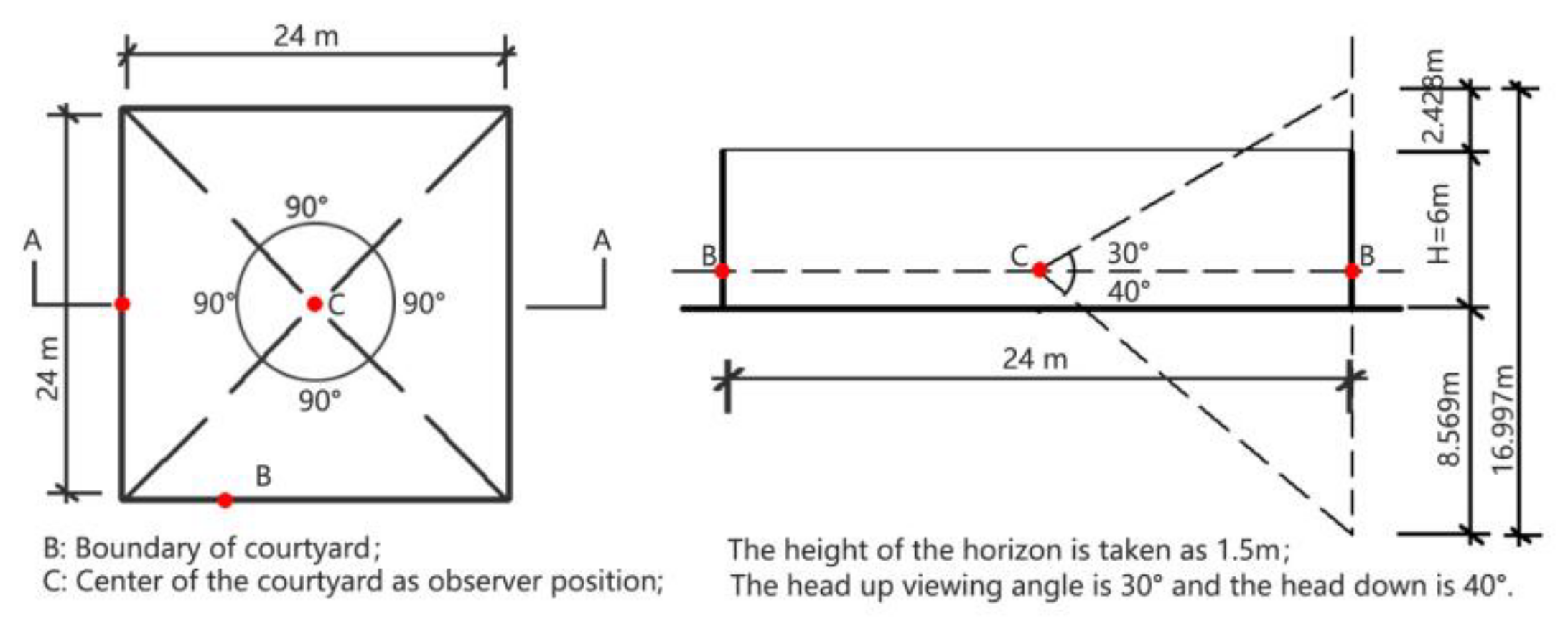
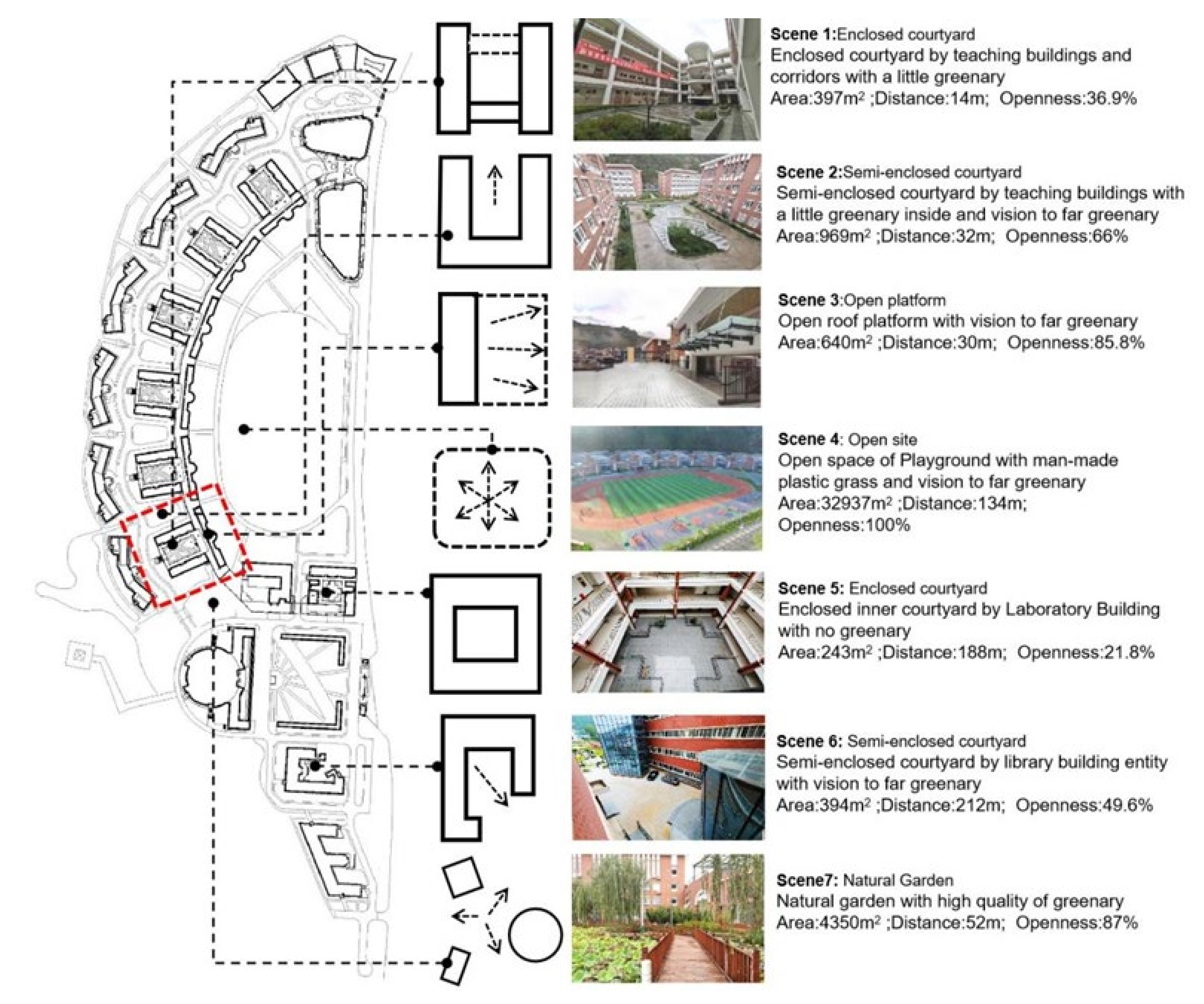
| Scene Code. | Total PRS | Restorative Feature Dimension | |||
|---|---|---|---|---|---|
| GA | F | E | C | ||
| Mean (SD) | Mean (SD) | Mean (SD) | Mean (SD) | Mean (SD) | |
| Scene 1 | 3.15(0.43) | 3.06(0.62) | 3.19(0.62) | 3.62(0.70) | 2.53(0.67) |
| Scene 2 | 3.30(0.50) | 3.40(0.70) | 3.38(0.72) | 3.52(0.70) | 2.60(0.80) |
| Scene 3 | 3.56(0.56) | 3.78(0.76) | 3.65(0.71) | 3.73(0.75) | 2.61(0.98) |
| Scene 4 | 3.51(0.60) | 3.79(0.86) | 3.52(0.77) | 3.68(0.76) | 2.70(1.02) |
| Scene 5 | 3.21(0.54) | 3.09(0.68) | 3.32(0.71) | 3.53(0.74) | 2.70(0.86) |
| Scene 6 | 3.31(0.54) | 3.39(0.75) | 3.36(0.68) | 3.53(0.72) | 2.71(0.82) |
| Scene 7 | 3.90(0.53) | 4.17(0.72) | 4.13(0.66) | 3.90(0.67) | 2.77(0.91) |
| Scene Code. | Scene 1 | Scene 2 | Scene 3 | Scene 4 | Scene 5 | Scene 6 |
|---|---|---|---|---|---|---|
| Scene 2 | 0.15 * | |||||
| Scene 3 | 0.40 * | 0.25 * | ||||
| Scene 4 | 0.36 * | 0.21 * | −0.04 | |||
| Scene 5 | 0.06 | −0.09 | −0.35 * | −0.30 * | ||
| Scene 6 | 0.16 * | 0.01 | −0.24 * | −0.20 * | 0.10 * | |
| Scene 7 | 0.75 * | 0.60 * | 0.34 * | 0.39 * | 0.69 * | 0.58 * |
| Spatial Characteristic | Correlation | Correlation for Restorative Feature | ||||
|---|---|---|---|---|---|---|
| Total PRS | BA | F | E | C | ||
| Area | r | 0.108 | 0.173 | 0.047 | 0.037 | 0.026 |
| p-value | 0.000 ** | 0.000 ** | 0.062 | 0.139 | 0.299 | |
| Distance | r | −0.092 | −0.101 | −0.090 | −0.078 | 0.052 |
| p-value | 0.000 ** | 0.000 ** | 0.000 ** | 0.002 ** | 0.038 * | |
| Openness | r | 0.319 | 0.405 | 0.256 | 0.118 | 0.024 |
| p-value | 0.000 ** | 0.000 ** | 0.000 ** | 0.000 ** | 0.351 | |
| Scene Code. | Short-Term Break | Long-Term Break | Reported Favorite Places | |||
|---|---|---|---|---|---|---|
| Number | Rate | Number | Rate | Number | Rate | |
| Scene 1 | 195 | 55.1% | 92 | 26.0% | 56 | 15.8% |
| Scene 2 | 29 | 8.2% | 20 | 5.6% | 37 | 10.5% |
| Scene 3 | 64 | 18.1% | 74 | 20.9% | 141 | 39.8% |
| Scene 4 | 34 | 9.6% | 110 | 31.1% | 220 | 62.1% |
| Scene 5 | 0 | 0 | 1 | 0.3% | 2 | 0.6% |
| Scene 6 | 0 | 0 | 4 | 1.1% | 2 | 0.6% |
| Scene 7 | 31 | 8.8% | 39 | 11% | 147 | 41.5% |
| Scene 8 | 1 | 0.3% | 14 | 4% | 12 | 3.39% |
| Mapping Results | 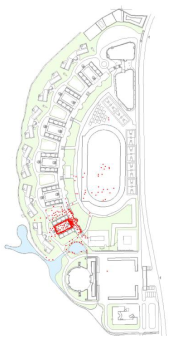 | 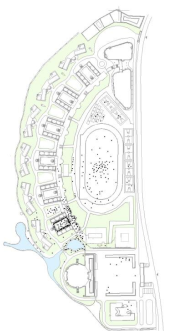 | 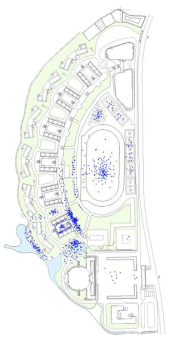 | |||
Publisher’s Note: MDPI stays neutral with regard to jurisdictional claims in published maps and institutional affiliations. |
© 2022 by the authors. Licensee MDPI, Basel, Switzerland. This article is an open access article distributed under the terms and conditions of the Creative Commons Attribution (CC BY) license (https://creativecommons.org/licenses/by/4.0/).
Share and Cite
Bai, X.; Li, X.; Yan, D. The Perceived Restorativeness of Outdoor Spatial Characteristics for High School Adolescents: A Case Study from China. Int. J. Environ. Res. Public Health 2022, 19, 7156. https://doi.org/10.3390/ijerph19127156
Bai X, Li X, Yan D. The Perceived Restorativeness of Outdoor Spatial Characteristics for High School Adolescents: A Case Study from China. International Journal of Environmental Research and Public Health. 2022; 19(12):7156. https://doi.org/10.3390/ijerph19127156
Chicago/Turabian StyleBai, Xiaoxia, Xinxin Li, and Ding Yan. 2022. "The Perceived Restorativeness of Outdoor Spatial Characteristics for High School Adolescents: A Case Study from China" International Journal of Environmental Research and Public Health 19, no. 12: 7156. https://doi.org/10.3390/ijerph19127156
APA StyleBai, X., Li, X., & Yan, D. (2022). The Perceived Restorativeness of Outdoor Spatial Characteristics for High School Adolescents: A Case Study from China. International Journal of Environmental Research and Public Health, 19(12), 7156. https://doi.org/10.3390/ijerph19127156






